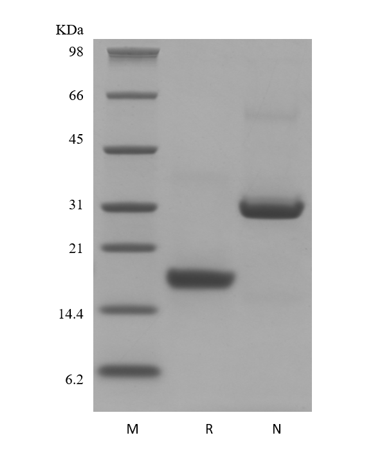- Synonyms
- CSF-1, MGI-IM
- Source
- Escherichia coli.
- Molecular Weight
- Approximately 36.8 kDa, a disulfide-linked homodimer consisting of two 158 amino acid polypeptide chains.
- AA Sequence
- EEVSEYCSHM IGSGHLQSLQ RLIDSQMETS CQITFEFVDQ EQLKDPVCYL KKAFLLVQDI MEDTMRFRDN TPNAIAIVQL QELSLRLKSC FTKDYEEHDK ACVRTFYETP LQLLEKVKNV FNETKNLLDK DWNIFSKNCN NSFAECSSQG HERQSEGS
- Purity
- > 95 % by SDS-PAGE and HPLC analyses.
- Biological Activity
- Fully biologically active when compared to standard. The ED50 as determined by a cell proliferation assay using murine M-NFS-60 cells is less than 1 ng/ml, corresponding to a specific activity of > 1.0 × 106 IU/mg.
- Physical Appearance
- Sterile Filtered White lyophilized (freeze-dried) powder.
- Formulation
- Lyophilized from a 0.2 μm filtered solution in PBS, pH7.4.
- Endotoxin
- Less than 1 EU/μg of rHuM-CSF as determined by LAL method.
- Reconstitution
- We recommend that this vial be briefly centrifuged prior to opening to bring the contents to the bottom. Reconstitute in sterile distilled water to a concentration of 0.1 mg/mL. Stock solutions should be apportioned into working aliquots and stored at ≤ -20 °C. Further dilutions should be made in appropriate buffered solutions.
- Stability & Storage
- Use a manual defrost freezer and avoid repeated freeze-thaw cycles.
- 12 months from date of receipt, -20 to -70 °C as supplied.
- 1 month, 2 to 8 °C under sterile conditions after reconstitution.
- 3 months, -20 to -70 °C under sterile conditions after reconstitution.
- Usage
- This material is offered by Shanghai PrimeGene Bio-Tech for research, laboratory or further evaluation purposes. NOT FOR HUMAN USE.
- SDS-PAGE

- Reference
- 1. Cosman D, Wignall J, Anderson D, et al. 1988. Behring Inst Mitt: 15-26.
2. Metcalf D, Willson T, Rossner M, et al. 1994. Growth Factors, 11: 145-52.
3. Hidaka T, Fujimura M, Nakashima A, et al. 2002. Jpn J Cancer Res, 93: 426-35.
4. Kubota Y, Takubo K, Shimizu T, et al. 2009. J Exp Med, 206: 1089-102.
- Background
- Macrophage Colony Stimulating Factor (M-CSF), also named CSF-1, is a hematopoietic growth factor that is involved in the proliferation, differentiation, and survival of monocytes, macrophages, and bone marrow progenitor cells. It is produced by osteoblasts (as a result of endocrine stimulation by parathyroid hormone) exerts paracrine effects on osteoclasts and can interact with CSF1R. M-CSF is a four α-helical bundle cytokine and its active form is found extracellularly as a disulfide-linked homodimer. Four transcript variants encoding three different isoforms have been reported for M-CSF gene. Although forms may vary, all of them contain the N-terminal 150 a.a. portion that is necessary and sufficient for interaction with the receptor. The first 223 a.a. of mature human M-CSF shares 88 %, 86 %, 81 % and 74 % sequence identity with corresponding regions of dog, cow, mouse and rat M-CSF, respectively. Human M-CSF is active in the mouse, but mouse M-CSF is reported to be species-specific.









 COA Application
COA Application


